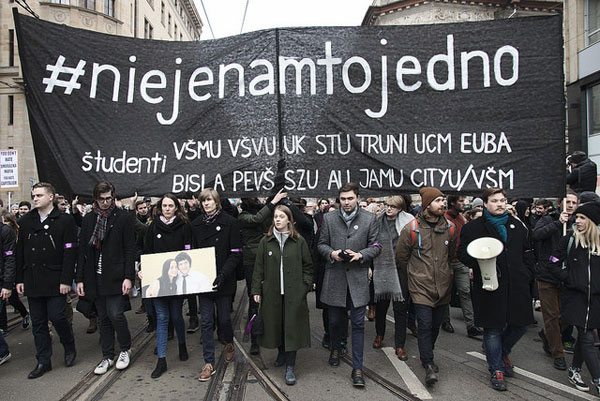
March 17, 2018; New York Times
Nearly a year after we questioned whether an Arab Spring-like uprising was emerging in Europe, resistance to authoritarian leaders and mounting corruption has moved in fits and starts. Young Slovaks, who have been leading the country’s largest demonstrations since the Velvet Revolution, found success last week when their protests resulted in the resignation of Slovakia’s prime minister. Beginning in April 2017 as an anticorruption campaign, the latest demonstrations were spurred by the recent killing of an investigative journalist who was trying to expose Italian organized crime.
“This past week the protests forced the resignation of Prime Minister Robert Fico, but they have shown little sign of abating as the demonstrators, many of them young people, appear determined to safeguard hard-won freedoms,” reporter Marc Santora wrote. “Despite freezing temperatures, snow and rain—men, women and children have demonstrated in numbers unseen since the fight to break from the yoke of the Soviet Union.”
The activists leading the campaign were just high schoolers when it began, but their idealism has helped fuel the fight. Similarly, the Parkland school shooting survivors who have been leading the March for Our Lives movement across the US have also been lauded—and mocked—for their audacious determination to enact new gun control measures. Politico, somewhat cynically, argued that society should prepare the teens for a long, bitter fight ahead.
Elsewhere in Europe, the story is playing out differently. As the New York Times notes, “a loss of faith in democracy has prompted voters to turn to populist leaders offering a strong hand as a remedy…In Hungary and Poland, those leaders have steadily embedded networks of cronies, dismantled democratic institutions and promoted what they say are traditional, national values over Western ones.”
Sign up for our free newsletters
Subscribe to NPQ's newsletters to have our top stories delivered directly to your inbox.
By signing up, you agree to our privacy policy and terms of use, and to receive messages from NPQ and our partners.
We’ve reported on the crackdown on civil society in both countries over the past few years, as Hungary approved new restrictions on foreign-funded NGOs and educational institutions, following the lead of Poland and Romania. And, the recent response in Poland to legislation that would curtail abortion rights appeared much less robust than the outcry that produced the country’s Black Monday protest in 2016.
While the New York Times focuses on the success of the Slovaks, resistance in these other European countries has slowed the creep of authoritarian leaders. The George Soros-backed Central European University was reaccredited last month after widespread protests and pushback from across the world and the executive arm of the European Union.
Meanwhile, the Slovak activists seem to understand the long game when it comes to change—the Times notes that the prime minister ensured that his party would continue to be in control even after he resigns. And, elections may not solve any of the country’s problems: “For all the democratic fervor of recent days, Slovakia has not been immune to the appeals of extremist politicians. In the last election, a far-right party with links to neo-Nazis won the most votes in its history.”
Will Slovakia move forward or backward? What will America’s teenage activists do for their second act? As Ruth McCambridge put it: high schoolers remind us what democracy looks like. We should sit up and pay attention.—Anna Berry













